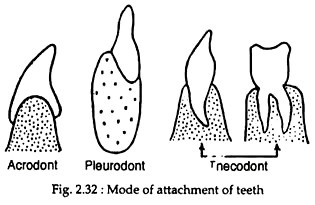In this article we will discuss about the types of dentition in mammals.
A. According to the Shape and Size of the Teeth:
(i) Homodont:
Homodont or isodont type teeth is a condition where the teeth are all alike in their shape and size, e.g. the toothed whales (Odontoceti). Pinnipedians show a tendency towards homodont condition. Fishes, amphibians, reptiles and in the extinct toothed birds, homodont or isodont condition is observed.
(ii) Heterodont:
ADVERTISEMENTS:
This condition is the usual feature in mammals, i.e. the teeth are distinguished according to their shape, size and function. The function is also different at different parts of the tooth row. Except mammals heterodont condition is found in Port Jackson Shark (Heterodontus), in several reptiles, specially among mammal-like reptiles.
B. According to the Mode of Attachment of Teeth:
(i) Thecodont:
This type of dentition is the rule among mammals. In this condition, the teeth are lodged in bony sockets or alveoli of the jaw bone (Fig. 2.32). Capillaries and nerves enter the jaw bone and the pulp cavity through the open tips of the hollow roots (Fig. 2.31).
Except mammals, the codont types of teeth are found in crocodiles and in some fishes (Haddock, Garpike and Barracuda). Among vertebrates, in addition to the codont dentition, acrodont and pleurodont type of dentition are also found.
ADVERTISEMENTS:
(ii) Acrodont:
In this type the teeth are fused to the surface of the underlying jawbone. These have no roots and are attached to the edge of the jawbone by fibrous membrane (Fig. 2.32) e.g. fishes, amphibians and some reptiles. In amphibians if teeth are present, that are acrodont and homodont type except Necturus. The acrodont-possessing reptiles are Sphenodon, Calotes, Draco, Agama, Uromastix, Moloch horridus and some snakes.
(iii) Pleurodont:
ADVERTISEMENTS:
Here the teeth are attached to the inner side of the jawbone. The tooth touches the bone only with the outer surface of its root (Fig. 2.32). In acrodont and pleurodont types of dentition, there are no roots, and nerves and blood do not enter the pulp cavity at the base, e.g. Necturus (Amphibia) and some reptiles.
Among reptiles the following families possess the pleurodont type of teeth: Iguanidae (Iguana), Xenosauridae (Xenosaurus, Mexico), Zonuridae (Africa), Anguidae (Anguis, Ophisaurus), Lacretidae (Lacerta), Scincidae (Mabuya), Helodermatidae (Heloderma, Mexico), Varanidae (Varanus), Gerrhosauridae (Africa) and many snakes.
C. According to the Succession or Replacement of Teeth:
According to the succession or replacement, the teeth can be divided into three categories:
(i) Monophyodont
(ii) Diphyodont and
(iii) Polyphyodont.
Among mammals the first two categories are found.
(i) Monophyodont:
In some mammals, only one set of teeth develops in their lifetime and this condition is called monophyodont, e.g., marsupials retain all their milk teeth except last premolars, the toothed whales (Odontoceti), some rodents (e.g. squirrels), and certain insectivores (e.g. moles).
ADVERTISEMENTS:
The platypus, sirenians and toothless whales develop only one set of teeth. These teeth may not erupt (some whales) or, if these develop, are usually shed shortly afterward.
(ii) Diphyodont:
In most mammals two sets of teeth are found. The first temporary set of teeth, called deciduous teeth or milk teeth or lacteal teeth, are lost or replaced by a second permanent teeth. In bats and guinea-pigs the milk teeth are lost even before birth.
(iii) Polyphyodont:
In this condition, the teeth are replaced continuously throughout life e.g. most vertebrates replace their teeth generation after generation (dogfish, snakes).
